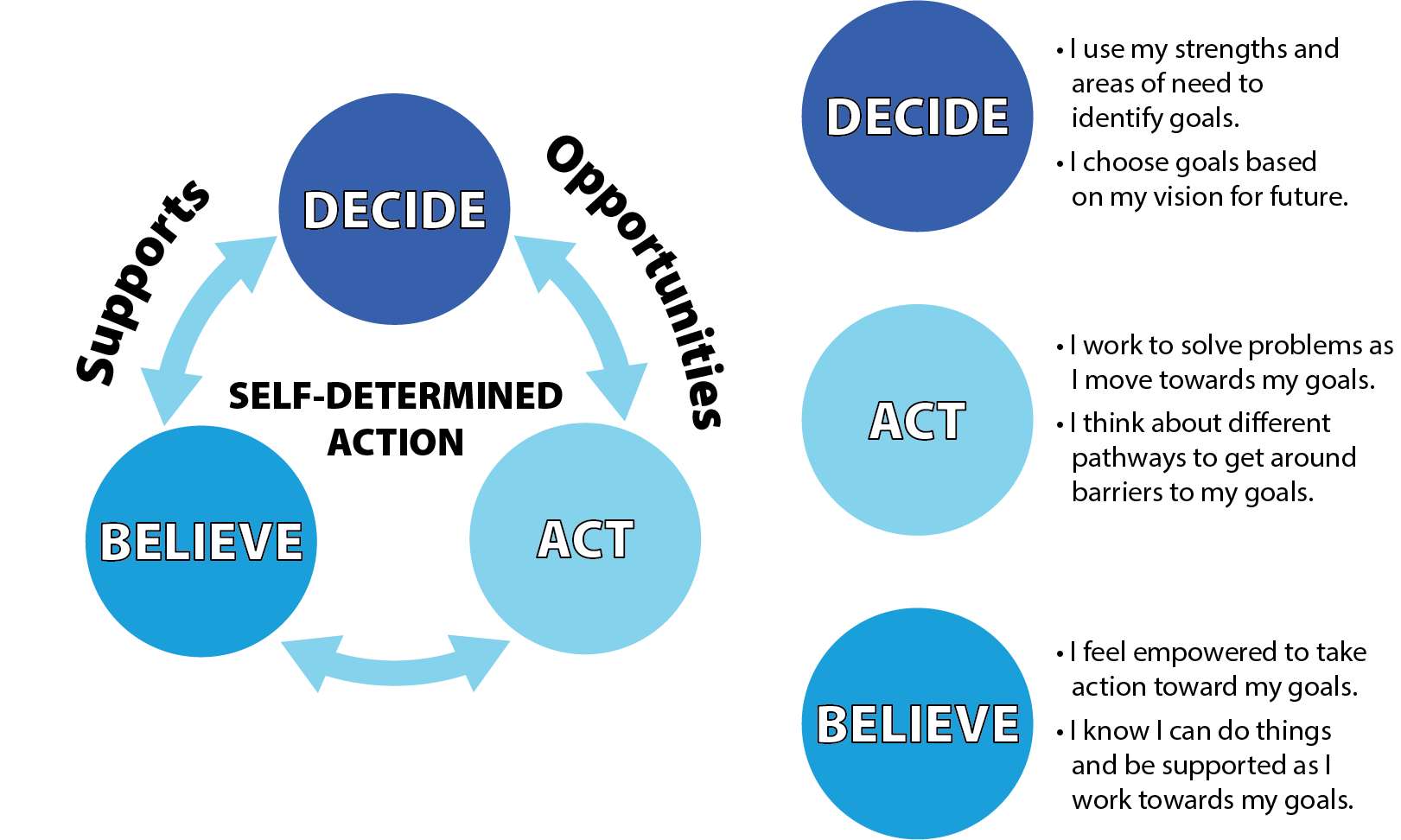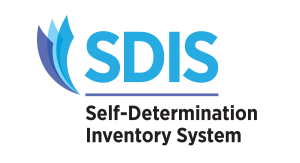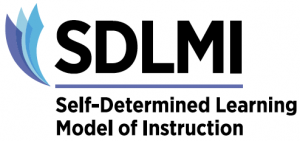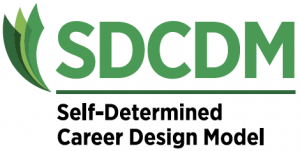
CURRENT RESEARCH PROJECTS
Check out the current research projects around self-determination and related work being conducted at KU Center for Developmental Disabilities. If you are interested in learning more, contact us.

SELF-DETERMINED ACTION FRAMEWORK
Self-determined people are causal agents who act in service to freely chosen goals. They make, or cause, things to happen in their lives through goal setting and attainment strategies. The framework below helps describe self-determined action.

The Self-Determination Inventory System (SDIS), available online, is a suite of tools that measure a person’s self-determination.
- Self-Determination Inventory: Student Report (SDI:SR)
- Self-Determination Inventory: Parent/Teacher Report (SDI:PTR)
- Self-Determination Inventory: Adult Report (SDI:AR)
SELECTED RESEARCH ON THE SDIS
Shogren, K. A., Little, T. D., Grandfield, B., Raley, S. K., Wehmeyer, M. L., Lang, K., & Shaw, L. A. (2018). The Self-Determination Inventory-Student Report: Confirming the factor structure of a new measure. Assessment for Effective Intervention. Advance online publication. doi:10.1177/1534508418788168
Shogren, K. A., Shaw, L. A., & Raley, S. K., & Wehmeyer, M. L. (2018). The impact of personal characteristics on scores on the Self-Determination Inventory: Student Report in adolescents with and without disabilities. Psychology in Schools, 55,1013-1026. doi:10.1002/pits.22174
Shogren, K. A., Shaw, L. A., Raley, S. K., &Wehmeyer, M. L. (2018). Exploring the effect of disability, race/ethnicity, and socioeconomic status on scores on the Self-Determination Inventory: Student Report. Exceptional Children, 85(1), 10-27. doi:10.1177/0014402918782150
Research over the last 25 years has shown using the Self-Determined Learning Model of Instruction (SDLMI) enables students with and without disabilities to achieve self-selected goals and positive in-school and post-school outcomes, such as:
- Access to and performance in general education curriculum
- Transition skills
- Health-related skills
Click here to find more information about the SDLMI.
The table below includes recent research studies that used the SDLMI.
SELECTED RESEARCH ON THE SDLMI
| Authors | Number of Participants | Age of Participants | Outcomes |
| Raley, Shogren, & McDonald (2018) | 34 | 14 to 16 years old |
|
| Shogren, Palmer, Wehmeyer, Williams-Diehm, & Little (2012) | 312 | 13 to 21 years old |
|
| Shogren, Wehmeyer, Palmer, Rifenbark, & Little (2015) | 779 | 14 to 21 years old |
|
| Wehmeyer et al. (2012) | 312 | 13 to 21 years old |
|
Additional Research
Agran, M., Wehmeyer, M., Cavin, M., & Palmer, S. (2010). Promoting active engagement in the general education classroom and access to the general education curriculum for students with cognitive disabilities. Education and Training in Autism and Developmental Disabilities, 45,163–174.
Cote, D. L., Jones, V. L., Barnett, C., Pavelek, K., Nguyen, H., & Sparks, S. L. (2014). Teaching problem solving skills to elementary age students with autism. Education and Training in Autism and Developmental Disabilities, 49,189–199.
Hagiwara, M., Shogren, K., Lane, L., Raley, S. (2020) Development of the Self-Determined Learning Model of Instruction Coaching Model: Implications for research and practice. Education and Training in Autism and Developmental Disabilities, 2020, 55(1), 17–27.
Kelly, J. R., & Shogren, K. A. (2014). The impact of teaching self-determination skills on the on-task and off-task behaviors of students with emotional and behavioral disorders. Journal of Emotional and Behavioral Disorders, 22,27–40. doi:10.1177/1063426612470515
Mazzotti, V., Test, D., & Wood, C. (2012). Effects of multimedia goal-setting instruction on students’ knowledge of the Self-Determined Learning Model of Instruction and disruptive behavior. Journal of Positive Behavior Intervention, 15,90–102. doi:10.1177/1098300712440452
Mazzotti, V. L., Wood, C. L., Test, D. W., & Fowler, C. H. (2012). Effects of computer-assisted instruction on students’ knowledge of the Self-Determined Learning Model of Instruction and disruptive behavior. Journal of Special Education, 45,216–226. doi:10.1177/0022466910362261
Raley, S. K., Hagiwara, M., Burke, K. M., Kiblen, J. C., & Shogren, K. A. (2022). Supporting All Students to Be Self-Determined: Using the Self-Determined Learning Model of Instruction Within Multi-Tiered Systems of Supports. Inclusive Practices, 2(1), 3–12. https://doi.org/10.1177/27324745221132478
Shogren, K. A., & Raley, S. K. (2023). The Self-Determined Learning Model of Instruction: A Practitioner’s Guide to Implementation for Special Education. Routledge Taylor & Francis Group.
The Self-Determined Career Design Model (SDCDM) is an evidence-based model of instruction that enables youth and adults to achieve more positive outcomes related to:
- Postsecondary education
- Employment
- Community participation
Click here to find more information about the SDCDM.
The table below includes recent research studies that used the SDCDM.
SELECTED RESEARCH ON THE SDCDM
| Authors | Participants | Setting | Positive Outcomes |
| Dean, Shogren, Wehmeyer, Almire, & Mellenbruch (2019) | 12 adults with intellectual disability | Community | Nine out of the 12 participants found integrated employment after the year of SDCDM implementation. |
| Dean, Burke, Shogren, & Wehmeyer (2017) | 3 young adults with intellectual disability | Community | The job seekers learned more about their strengths and interests. They also changed their employment status in line with their goals. |
| Sowers & Swank (2017) | 67 young adults with mental health diagnoses | Community | Enhanced self-determination and increased career planning engagement were achieved. |
| Shogren et al. (2016) | 197 adults with disabilities | Community | People who worked through the SDCDM increased their self-determination scores. |



